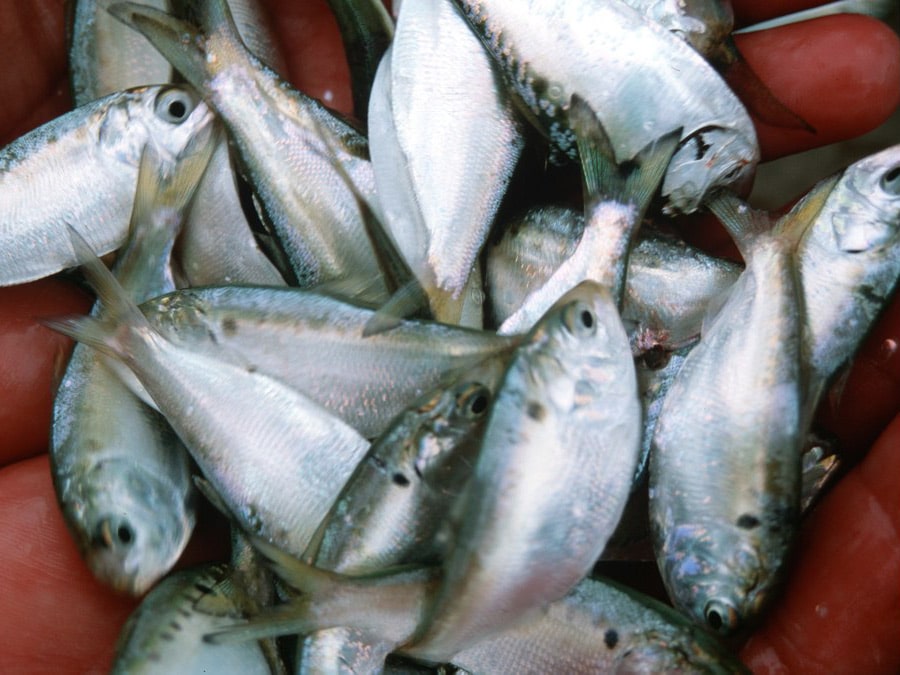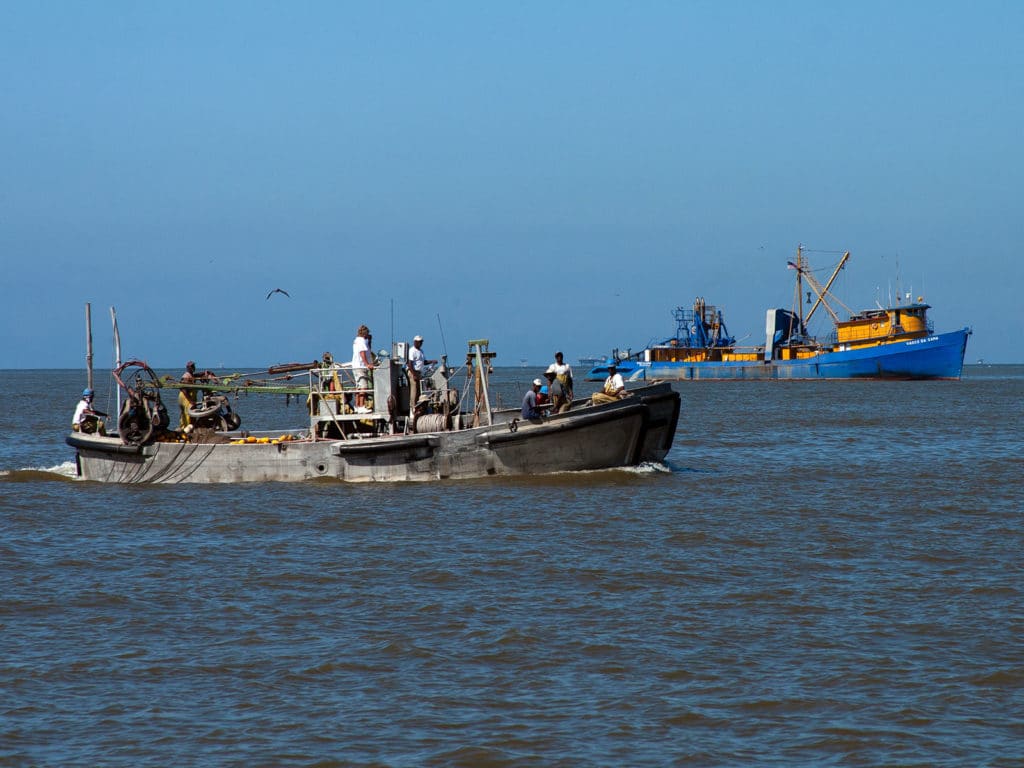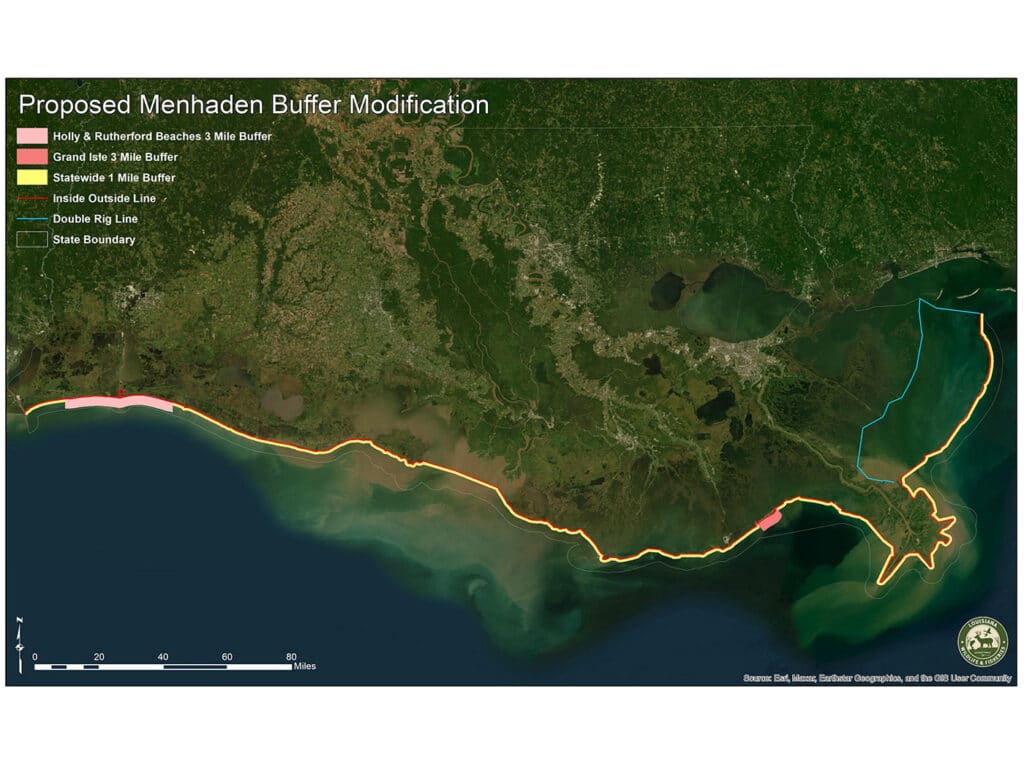
Louisiana has been the one state among the five bordering the Gulf of Mexico that has welcomed the entire Gulf fleet of commercial menhaden net boats. The other four Gulf states have either banned commercial menhaden netting outright or have rules strict enough that Gulf netters focus entirely on Louisiana where for practical purposes, pursuit of the vital forage fish is wide open. That translates into at least a billion pounds of pogies harvested in foreign nets in the Gulf, almost all of it off Louisiana, in a year. About 70 percent of that billion comes from state waters — within three miles of the coast.
The oily little fish are reduced to fertilizer and animal feed. Those not scooped up in purse seines serve the Gulf as ecologically essential filter feeders that help keep Gulf waters clean. Of course, menhaden are also vital forage for marine mammals and nearly all nearshore predatory game fish.
South Africa and Canada, they must love Louisiana, being the only Gulf state to give commercial menhaden net boats belonging to Daybrook Fisheries (South Africa owned) and Omega Protein (Canada owned) nearly unlimited access to the state’s coast and its menhaden resource.
But those industrial net boats have nasty habits that, for some Louisiana anglers and conservation groups, render them less-than-welcome guests. One is their tendency to dump great numbers of fish, as in September 2023, when an estimated 850,000 fish were dumped by commercial menhaden net boats just off the beach in southwest Louisiana. As a result, the dead menhaden formed huge, rotting rafts on the surface and on Louisiana beaches. Also left floating were hundreds of dead redfish, including many trophy-size bulls (populations of which have been declining in these waters in recent years).
Sadly, that fish spill was no isolated incident. For example, a year before, a single Omega Protein boat, overloaded with pogies, dumped nearly 1 million dead fish near Holly Beach. Fines? The Louisiana Wildlife and Fisheries Commission (LWFC) merely slapped the industry’s hand, saying it should make “reasonable attempts” to retrieve dead menhaden. Yeah, okay.
Commercial Menhaden Boats Can Wreck Inshore Waters

At least as damning as dead, wasted fish is the damage these big boats do as they continue to blunder through waters as shallow as 4 or 5 feet, tearing up the bottom in the shallow, fertile estuarial waters where fish feed and spawn. They also net up bycatch aplenty; studies have indicated 10,000 to 20,000 breeding-size redfish are killed in the Gulf by the menhaden fleet every year.
It’s not as if these foreign-owned fleets could be unaware of public concern — that’s been voiced loud and clear for years. It’s more that the netters lack any real motivation to worry about whatever damage they cause to the fragile shallows. The state’s governing agency, via the LWFC, has certainly heard the concerns voiced by those who care about the state’s environment, including sport fishermen, for years. Heard and ignored. In Louisiana politics, money talks. The menhaden operators have big money and powerful interests behind them. They can also get standing-room-only crowds of crews and pogy-reduction workers to fill and dominate commission meetings.
Those interests concerned about the big diesel seiners trashing coastal waters had reason to believe the commission, at its early February meeting, might finally consider setting a minimal buffer zone of a mile that would require the boats to stay at least that far from shore.
But once again the LWFC opted to kick the can down the road, let the netters keep netting and work on a compromise. They heard dire industry warnings (one pogy-boat captain saying not allowing pogy boats to fish along shorelines would be “the beginning of the end” for the menhaden fishery). And then there’s a Department of Wildlife and Fisheries study that establish that buffer zone could cost the fishery $31 million per year and lead to lost jobs. Menhaden operations like to fish very shallow because their spotter planes more easily find schools of fish and more easily catch them in their purse seines.
However, the lead author of that same study said the industry could recoup some of those losses by simply fishing out a bit deeper. One commissioner said at the early February meeting, “It’s a little absurd, a little childish that the industry, being the good fishermen and businessmen that they are, can’t still catch a billion fish just a little farther out.”
A Possible Buffer from Commercial Boats

Yet after the meeting that offered no resolution and little promise, there was a glimmer of hope. According to Chris Macaluso, director of the Theodore Roosevelt Conservation Partnership’s Center for Marine Fisheries, “The menhaden industry and Coastal Conservation Association representatives met with a member of the commission and a state legislator. It was made clear to both sides that a compromise is a must.” And at the time of this writing, a special meeting of the commission was scheduled to revisit a notice of intent to create a buffer of some sort, and to draw up a compromise between the industry, conservation interests and anglers.
Macaluso says, “I think the two sides are getting close,” and notes that a compromise agreement is the only thing on the meeting agenda. That compromise means boats will probably not be required to stay a mile off the beach, which to many seems a reasonable minimum, but at least some buffer would be in effect, at least somewhat farther from the shoreline than the pogy boats fish now.
For Macaluso, “It’s honestly encouraging. It’s not all that recreational fishermen were hoping for, but it seems a good path.” He notes that fish kills and bycatch issues still need to be addressed, but expects more protected areas to be established. So one can only hope that Louisiana will finally establish by rule some minimal protection for its valuable coastal environment and resources.









